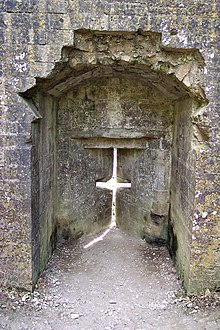
Back شق السهم Arabic Байніца Byelorussian Байніца BE-X-OLD Aspillera Spanish Saietera Basque درزپیکان Persian Meurtrière French Seteira Galician Balestriera Italian 狭間 Japanese


An arrowslit (often also referred to as an arrow loop, loophole or loop hole, and sometimes a balistraria[1]) is a narrow vertical aperture in a fortification through which an archer can launch arrows or a crossbowman can launch bolts.
The interior walls behind an arrow loop are often cut away at an oblique angle so that the archer has a wide field of view and field of fire. Arrow slits come in a variety of forms. A common one is the cross, accommodating the use of both the longbow and the crossbow. The narrow vertical aperture permits the archer large degrees of freedom to vary the elevation and direction of their bowshot but makes it difficult for attackers to harm the archer since there is only a small target at which to aim.
Balistraria, plural balistrariae, from balister, crossbowman[1][2] can often be found in the curtain walls of medieval battlements beneath the crenellations.
- ^ a b Rev. Thomas Davidson (1903). "Balistraria; Balister". Chambers's Twentieth Century Dictionary.
Balistraria, bal-is-trar'i-a, n. An aperture or loophole in the wall of a fortification through which crossbowmen might discharge their bolts. Balister (pbs.), name for an arbalester or crossbowman, also an arbalest or crossbow itself.
- ^ "balistraria". Merriam-Webster.com Dictionary. Retrieved 1 July 2019.
© MMXXIII Rich X Search. We shall prevail. All rights reserved. Rich X Search